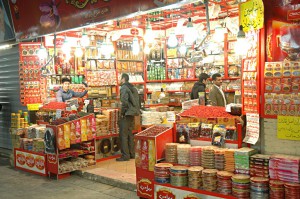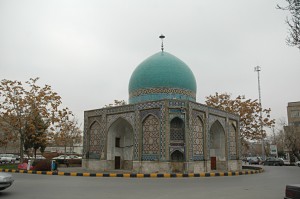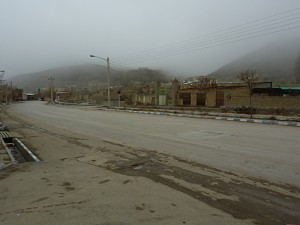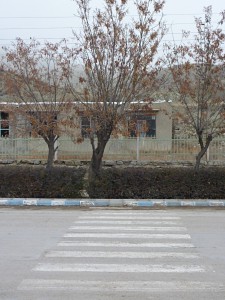The last real stop in Iran was the city of Mashhad. The second largest city of the country is home of the shirne of Imam Reza, the eighth Imam of the Shia. The shrine is the destination of the pilgrims, but the city grew during the war with Irak.
Mashhad is all about the Imam Reza. The long distance connections by bus and train are sold out during high pilgrimage season. I was lucky once again as well to get the seat from Yazd on the train of a person who had cancelled their trip. The three other people in my compartment were pilgrims to visit the shrine.
Before aqrriving at Mashhad and in the first sunlight of the day, I enjoyed the last signs of desert from the train. Later on, the traces of agriculture became once again very present. The rising sun and the dark clouds were a sight to remember.
Intersection on major roads are very rare on Iranian roads, instead one has to turn right, on the major road only to perform a U-turn a little bit down the road. It came as quite a surprise that the same seems to be true for trains as well. Just before arriving in Mashhad, the train passed a train station only to perform a large loop and pass the same train station in the opposite direction a little bit later.
Taxis in Mashhad proved to be another surprise: the used the meters. And the rates are very reasonable. The price for a ride was remarkably cheaper than in the smaller cities where they had fixed prices from the bus station. Once at the hotel I received the information, that a room was indeed available, but I could only check-in after 2pm. I was fortunate enough to be allowed to leave my backpack at the hotel. So I took my camera and started to discover the city. Obviously even without a city map, I ended up in the bazaar. Compared to all the cities I visited in Iran, the bazaar of Mashhad seemed very well organized. I felt much more in a shopping mall than in an oriental bazaar. Even the building is a fairly modern construction.
After checking out the two main drags of the bazaar, I planned to criss-cross back to my hotel. On the way I found a lovely mosque of which I took a picture. A nice man asked me of my whereabouts and where I was headed. I took the chance and told him I was looking for a coffeenet, an Internet Café. He helped me ask around and led me to the place. While I was gathering the most recent news and sending out a few e-mails, he was sitting near the entrance and every now and then glanced on my screen to see what I was doing. I got the impression he was part of the local anti-espionage police. I decided to do more time-intensice stuff later on, and he asked me where I wanted to go next. I told him, that I would like to go to my hotel, since I figured, that was one way of getting rid of him. He kept asking around where my hotel was, even though I had tried to explain to him, that I knew which way to go. In front of the hotel his kindness became obvious: he wanted to be given some money for his help. I gave him the equivalent of 50 US-cents and he walked off happily.
I finished my blog post of Yazd in the hotel. Then I decided it was time to visit the Imam too, since I didn’t want to be too late getting to the Haram-e Razavi. At the gates I inquired whether I could walk into the complex. I was sent back and forth until a police man told me to bring my backpack to the left-luggage and wait for a guide to appear. The guide showed up a few minutes later and we started a tour of the Haram. Back and forth we walked through the courtyards, prayer rooms and I even got to see the room containing the shrine. I saw many places which are usually forbidden for non-Muslim tourists. It is very good for the pilgrims, that photography inside the complex is forbidden, except for smartphones. The athmosphere is really breathtaking seeing all these people on the pilgrimage performing their procedure of reciting Quran verses and performing certain rituals. The holy shrine of the Imam Reza is the fourth most important pilgrimage site for Shias after Mecca, Najaf and Karbala.
From a pure secular point of view, the memorial site and the shrine are an incrediable maze of hallways and courtyards all covered with colorful tiles on the outside and mirrors on the inside. The photographer within me would have loved to snap away, but the honor of visiting such a holy location of another religion requires the corresponding respect.
In the evening I went back to the Internet Café zu finish my blog post about Yazd and ate a small dinner before heading back to the hotel.
Monday morning was again a day of departure. To be at the border to Turkmenistan at the indicated time to meet my guide on the Turkmen side, I decided to stay overnight directly at the border town of Bajgiran. At the hotel in Mashhad I asked how I would best travel to Bajgiran. Fortunately I cleaning lady overheard the discussion and told the hotel manager how this feat would best be accomplished, since he just wanted to send me to the main bus terminal. Instead I took a taxi to the Western part of the city, where the savaris, the shared taxis, leave for Quchan.
The decision which taxi to take proved to be a rather difficult task, since the dirvers started fighting about who could give me a ride. they started pulling on me and my backpack in all directions. I decided to take the one taxi, where the driver stood aside and offered his services. His companion told me to let go of my backpack and get into his car. One of the other drivers finally got hold of my backpack and took it into his car. There I was, sitting in one taxi with my backpack in the other. Finally the other driver handed the backpack over and we could go. The good part of the ride was, that the driver took me directly to Bajgiran, so I didn’t have to endure the taxi selection a second time, the bad part was, that there was a misunderstanding about the price. When I asked him about the fare, I showed me six fingers, which usually means 6000 Tomans, instead he asked for 60’000, which surprised me when we arrived in Bajgiran. Fortunately I still had that much money in Rial, and the rate was alright considering we rode more than 200 km.
Unfortunately there was not enough money left to pay for the hotel room. I again was lucky, since the manager accepted US dollars as a means for payment. After a short rest I started a walk up and down the main street of this uninviting border town to find some food and a money exchange. Not an easy feast when the town is almost completely deserted in the early afternoon. I finally walked into a small place where men were smoking and drinking tea. Just as I entered, I plate of food was carried back to the counter. I asked for the same and was served Abgoost, a traditional Iranian specialty, for the second time during this trip. The difference to the first time in Teheran in a posh restaurant was, that here everything was simple and truly traditional. Again I was helped in the procedure which had been performed by restaurant staff in Teheran by a local who spoke some English. The food was good and with a full stomach I left the place.
Just as I exited through the door, I was approached by a man asking whether I needed to change any money. I exchanged 20 US dollars for Turkmen manat to at least have a small amount of local currency when crossing the border.
Since Bajgiran has whether any attractions nor is in anyway attractive, I spent the rest of the day in my hotel room preparing the next few weeks of my journey. The countries of central asia will bring a whole new world: former Soviet republics with excentric heads of state and corrupt police.






